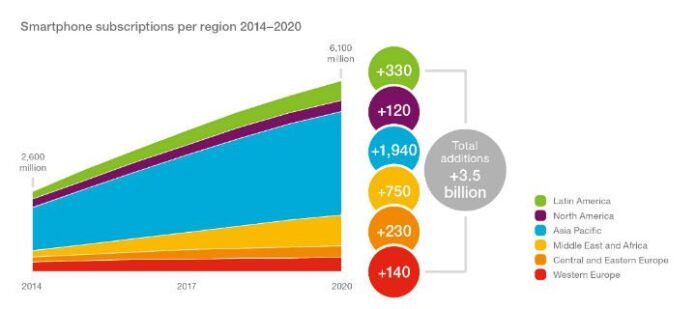Ericsson Mobility Report: As the decade ends, 90% of the globe will have access to mobile broadband networks
In the mobile technology landscape, 2020 is poised to be a big year. The latest Ericsson Mobility Report projects that by the end of the decade, 70% of all people will be using smartphones and 90% of the global population will be covered by mobile broadband networks.
Other key takeaways from the Ericsson Mobility Report, released June 3, also hinge on the 2020 milestone: between now and then, subscription plans for smartphones will double to 6.1 billion with 80% of new subscriptions coming out of the Asia-Pacific, Middle East and Africa regions.
Also by 2020, 80% of all mobile data traffic will originate with a smartphone with North America and Europe continuing to have the highest level of data usage per smartphone. Similarly, mobile video traffic will grow to 55% of all traffic by 2020, driven by video streaming and accessing online video content.
Rima Qureshi, an Ericsson SVP and chief strategy officer, said, “’This immense growth in advanced mobile technology and data usage, driven by a surge in mobile connectivity and smartphone uptake, will makes today’s big data revolution feel like the arrival of a floppy disk. We see the potential for mass-scale transformation, bringing a wealth of opportunities for telecom operators and others to capture new revenue streams. But it also requires greater focus on cost-efficient delivery and openness to new business models to compete and remain effective.”
The Ericsson Mobility Report tallies a 55% growth in mobile data traffic between Q1 2014 and the same increment in 2015. The authors point out the centrality of mobile to sports viewing as demonstrative of the ubiquity of mobile technology.
From the report: “The digital signatures of sports shows that real-time viewing, sharing results and social networking have become integral parts of sports events, creating a mix of real and virtual experiences. The combination of smartphones, apps and mobile broadband coverage at such events forms an enhanced spectator experience.”
The report also finds that LTE deployments are going strong, there’s still widespread opportunity associated with other legacy networks.
At this point, LTE has reached 600 million subscribers with 105 million new subscribers coming online in the first quarter of 2015.
Meanwhile, WCDMA/GSM added some 60 million subscribers during the same time increment. Most 3G and LTE users have access to GSM and EDGE as fallbacks, despite those network schemes losing 30 million subscribers in the time period covered.
The Ericsson Mobility Report also notes major growth in the “Internet of Things”/M2M space. There were 230 million cellular M2M subscriptions at the end of 2014 with that number expected to grow rapidly in the coming years.
For example: home security systems draw in data from alarms, door and window sensors, motion detectors, and other inputs through a cellular gateway.
“More things will be connected through capillary networks, using short-range radio to cellular gateways. This will leverage the ubiquity, security and management of cellular networks. A reduction in LTE modem prices will enable new applications with very low latency requirements. New developments of 5G capabilities are expected to extend the range of addressable applications for massive Machine-Type Communications deployments.”
The Ericsson Mobility Report projects 26 billion connected devices by 2020.
Click here to read the Ericsson Mobility Report.

